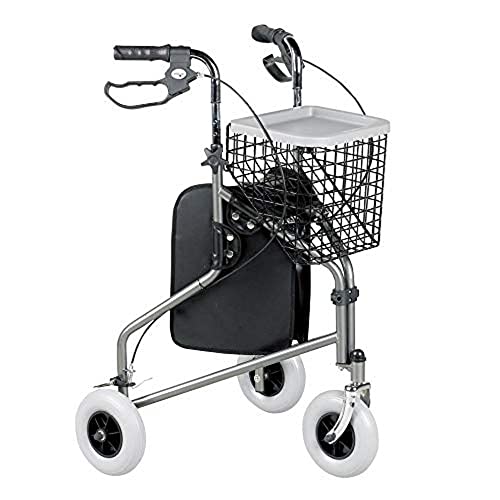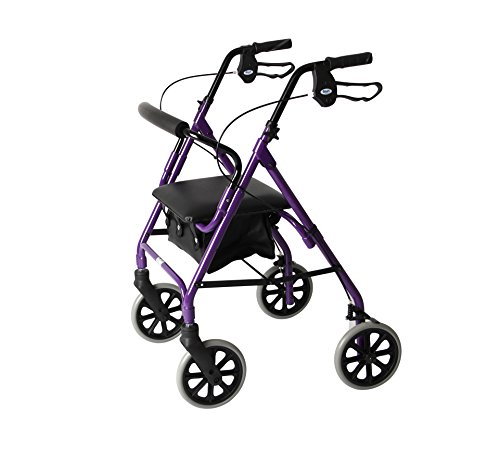20 Things Only The Most Devoted Rollator Walking Aid Fans Should Know
페이지 정보
작성자 Lynda 댓글 0건 조회 4회 작성일 24-09-10 17:28본문
 What Is a Rollator Walking Aid?
What Is a Rollator Walking Aid?A rollator is a type of walking aid that assists individuals to maintain their balance. This is achieved by increasing the base-of-support (BoS) when walking.
 It comes with brakes that can be easily engaged and it is able lock when the user stops or sits on the walker. Other features include a comfortable seat as well as a basket to hold personal belongings.
It comes with brakes that can be easily engaged and it is able lock when the user stops or sits on the walker. Other features include a comfortable seat as well as a basket to hold personal belongings.Stability
rollators for tall people offer greater stability and mobility compared to traditional walkers. They are an excellent choice for those who struggle with keeping their balance or need an upright base for walking. These mobility aids can help reduce the strain on joints as well as muscles that are healing, which could promote a faster recovery.
These mobility devices reduce the stress on joints in the lower extremities and also reduce strain on muscles. This is accomplished by spreading the weight over more of. This could reduce the pressure that is felt in the forefoot during walking downhill or uneven surfaces. The use of these devices may also help reduce pain in the forefoot by redistributing high plantar pressure to other areas of the foot.
The frame is an essential component of a rollator's stability because it is able to support the weight of the user. The frame is generally made of sturdy materials like steel or aluminum to ensure that the device doesn't buckle or collapse when under pressure. Additionally, the handle brakes on a rollator are a vital safety feature for users that allow them to slow down or stop if they're going too fast or have increased their speed.
While the frame of a rollator gives significant stability, it is not without its limitations. The weight and size could influence the device's ability to move around in various situations. Certain studies have revealed that the use of a walker with huge wheels causes the center of gravity to shift slightly to the left, which can negatively impact the way the device is used.
It is not a major issue, but it must be considered when buying a rollator. Many professionals recommend using the walker with smaller wheels for those who plan to spend a significant amount of time outdoors or in various walking conditions. The height of the handles is crucial to ensure that they are at the correct height for the user. This will prevent wrist fatigue and shoulder discomfort.
Support
In contrast to traditional walkers that offer a stable frame for support, rollators and walkers have four wheels that evenly distribute weight and help individuals traverse different terrains without risking falls. This allows them to be mobile both indoors and outside and live a more independent life with confidence. Rollators are also customizable with various features like adjustable handles, brakes, and wheel dimensions to meet your specific needs. In addition, some models include a seat for back support, as well as practical storage options to improve everyday mobility and comfort.
Although a rollator walker tall can provide better stability, it's vital to use it correctly to avoid accidents. It is recommended to have physical therapist or doctor oversee your transition from using a mobility device. They can provide you with an official prescription for the device and recommend the most appropriate one for your particular situation.
It is also crucial to adhere to the manufacturer's instructions regarding how to use your rollator. This will ensure that it is properly set up at the proper height and is a good fit for your body shape. It's also important to keep the device clean and lubricated regularly to increase its performance.
When using a walker with wheels ensure that you put your weight on the base of the device and not the wheels. Leaning on the wheels could be a safety hazard and could cause it to tip over. Do not let your child sit on top of an aid for mobility. This could put too much pressure on the wheels and result in them deteriorating quickly.
Some people who require a walking aid may be deterred from using one due to the cost. Insurance coverage and financial assistance can help offset the cost. Medicaid and Medicare, for example are able to classify the rollator and walker as durable medical equipment. This means that they may cover a portion the cost. In addition, flexible spending accounts (FSAs) and health savings account (HSAs) can be used to pay for these devices too. A rollator and transport chair is an effective and affordable tool that lets you to remain independent and mobile.
User-Friendliness
A rollator is an excellent alternative for those who wish to stay mobile and active but require some extra support. It's simple to maneuver and folds easily when not in use. A rollator can aid in improving walking performance by alleviating pressure on muscles and joints and enhancing balance.
A typical rollator scooter is frames that have between two and four wheel rollators wheels. The wheels make it simple to move since you don't need to lift the frame each time. Some models even have a seat, so you can rest when necessary.
While research is ongoing and ongoing, it is expected that using a walker can unload some joints and muscles while walking. This can result in a decrease of strength required for other activities and movements, such as stair-climbing or balance control while standing/squatting. This could contribute to the risk of falling seen in elderly rollator users.
It is crucial to choose a walker or rollator that is comfortable for the user. The handle should be held at the same height as the knee closest to it, and further away from the body. If you hold a walker too close to the body can cause strain on the back, neck, and arms. It's also important to consider the grip on a rolling walker. If the grip is not comfortable or doesn't meet an individual's needs, you can replace it with a different design. If the handle is too small or hard it is possible to get a grip made of plastic, foam, or another soft material may be more comfortable.
The walker or rollator must also be kept at a distance from the ground in order to prevent putting excessive pressure on the legs and feet. This reduces the risk of slipping and twisting an ankle or knee. It's also a good idea to have a backup device (like crutches or cane) in case the walker that rolls becomes unstable. It's not recommended to leave the rollator on uneven or stair-like floors for prolonged durations of time.
Convenience
A rollator can be a helpful mobility aid for those who struggle to walk long distances or who experience frequent falls. It can help reduce the impact of a fall and reduce the strain on injured muscles and joints. It can also boost confidence and encourage social interaction. If you're thinking of purchasing rolling a rollator, you need to think about the cost and whether your medical insurance will cover it. Medicare Part B policies may cover a portion of the cost if you have reached your annual deductible. Medicaid will typically also cover these devices.
Some people choose to use rollators as an alternative to a walker or cane however, it's better to continue using these other devices to provide stability and support when walking. A walker, for example, can help you maintain straight posture by keeping your arms level with your hips. It can also be held at a distance that is comfortable with your body. This can help prevent awkward postures that can cause a twisted ankle or knee.
It is important to keep in mind that if you choose to use a walker, you shouldn't hold it directly in front of your body or close. Handles on a standard walker are often higher than the user's arms. This can result in wrist flexion. This can lead to forefoot pain as well as a hallux rigidus by reducing the strength of the flexor muscles in the arms and hands. A rolling walker reduces this problem by lowering the handles to a level which is more in line with the styloideus ulnae.
Most rollators come with seating that can be used in public places or when doing the errands. This is particularly useful when you're out shopping and need to sit down. Some models come with a tray on the top of the seat, allowing you to carry snacks and beverages while out and out and about.
Be sure that the gadget you choose has a place to store your wallet, phone, and keys. Some models have a basket at the front of the frame while others have storage underneath the seat. Some walking models are fitted with a backpack strap that allows for ease of transport.
댓글목록
등록된 댓글이 없습니다.